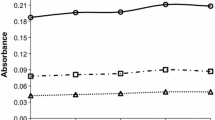Abstract
The method of Parsonset al. (1984) for measuring dissolved free amino acids (DFAA) in coastal seawater was modified. We found considerable interference in DFAA determination from ammonia dissolved in coastal seawater, although the interference of urea could be ignored. For DFAA analysis for coastal seawater samples, ammonia determinations for the same sample are needed to correct DFAA values. For coastal surface seawater samples from all over the Seto Inland Sea, Japan, values of DFAA ranged from undetectable to 1.87 μg-at N/l when corrected for ammonia, while uncorrected values ranged from undetectable to 2.61 μg-at N/l. DFAA, urea, nitrate+nitrite, ammonia and DON concentrations in surface seawater collected in the Seto Inland Sea were analyzed simultaneously. DFAA at four seasons constituted from 1.4 to 10.1% of DON, with a mean value of 6.5%. The concentration of urea was similar to that of DFAA and often higher than that of ammonium, although generally lower than that of nitrate.
Similar content being viewed by others
References
Benson, J. R. and P. E. Hare (1975): o-Phthalaldehyde: fluorimetric detection of primary amines in the picomole range. Comparison with fluorescamine and ninhydrin.Proc. Nat. Acad. Sci. USA,72, 619–622.
Carlucci, A. F., D. B. Craven and S. M. Henrichs (1984): Diel production and microheterotrophic utilization of dissolved free amino acids in sea waters off Southern California.Appl. Environ. Microbiol.,48, 165–170.
Dawson, R. and R. G. Pritchard (1978): The determination of α-amino acids in seawater using a fluorometric analyser.Mar. Chem.,6, 27–40.
Flynn, K. J. and I. Butler (1986): Nitrogen sources for the growth of marine microalgae: role of dissolved free amino acids.Mar. Ecol. Prog. Ser.,34, 281–304.
Hammer, K. D. and U. H. Brockman (1983): Rhythmic release of dissolved free amino acids from partly synchronizedThalassiosira rotula under nearly natural conditions.Mar. Biol.,74, 305–312.
Josefsson, B., P. Lindroth and G. Ostling (1977): An automated fluorescence method for the determination of total amino acids in natural waters.Anal. Chim. Acta,89, 21–28.
Keene, W. C., A. A. P. Pszenny, J. N. Galloway and M. E. Hawley (1986): Sea-salt corrections and interpretation of constituent ratios in marine precipitation.J. Geophys. Res.,91, 6647–6658.
Lampert, W. (1978): Release of dissolved organic carbon by graizing zooplankton.Limnol. Oceanogr.,23, 831–834.
Lindroth, P. and K. Mopper (1979): High performance liquid chromatographic determination of subpicomole amounts of amino acids by precolumn fluorescence determination with ophthaldialdehyde.Anal. Chem.,51, 1667–1674.
Maita, Y. and M. Yanada (1990): Vertical distribution of total dissolved nitrogen and dissolved organic nitrogen in seawater.Geochem. J.,24, 245–254.
Manahan, D. T. (1989): Amino acid fluxes and from seawater in axenic veliger larvae of a bivalve (Crassostrea gigas).Mar. Ecol. Prog. Ser.,53, 247–255.
Manahan, D. T., J. P. Davis and G. C. Stephens (1983): Bacteria free sea urchin larvae:selective uptake of neutral amino acids from seawater.Science,220, 204–206.
Matsunaga, K. and M. Nishimura (1972): Determination of urea in natural water by an improved Newell method.Japan Analyst,21, 1387–1389 (in Japanese with English abstract).
Mopper, K. and R. D. Zika (1987): Free amino acids in marine rains: evidence for oxidation and potential role in nitrogen cycling.Nature,325, 246–249.
Nell, J. A., M. E. Skeel and P. Dunkley (1983): Uptake of some dissolved organic nutrients by the Sydney rock oysterSaccostrea commercialis.Mar. Biol.,74, 313–318.
Newell, B. S., B. Morgan and J. Cundy (1967): The determination of urea in seawater.J. Mar. Res.,25, 201–202.
Parsons, T. R., Y. Maita and C. M. Lalli (1984):A Manual of Chemical and Biological Methods for Seawater Analysis. 173 pp., Pergamon Press, Oxford.
Sharp, J. H. (1983): The distributions of inorganic nitrogen and dissolved and particulate organic nitrogen in the sea. p. 1–35. In:Nitrogen in the Marine Environment, ed. by E. J. Carpenter and D. G. Capone, Academic Press, New York.
Stephens, G. C. and R. A. Schinske (1961): Uptake of amino acids by marine invertebrates.Limnol. Oceanogr.,6, 175–181.
Strickland, J. D. H. and T. R. Parsons (1972):A Practical Handbook of Seawater Analysis. 311 pp., Fish. Res. Bd. Canada, Bull. 167, Ottawa.
Tada, K., K. Monaka, M. Morishita and T. Hashimoto (1998): Standing stocks and production rates of phytoplankton and abundance of bacteria in the Seto Inland Sea.J. Oceanogr.,54, this issue, 285–295.
Tamaki, M., M. Shoga and T. Hiraki (1991): Precipitation chemistry by wet/dry sampler in Kobe.Chem. Soc. Japan,6, 930–935.
Williams, P. J. LeB (1970): Heterotrophic utilization of dissolved organic compounds in the sea. I. Size distribution of population and relationship between respiration and incorporation of growth substrates.J. Mar. Biol. Ass. U.K.,50, 859–870.
Yamamoto, T., O. Matsuda, T. Hashimoto and K. Tada (1997): Environmental conditions to support biological production. p. 19–27. In:Sustainable Development in the Seto Inland Sea, Japan, ed. by T. Okaichi and T. Yanagi, Terra Scientific Publishing Company, Tokyo.
Author information
Authors and Affiliations
Rights and permissions
About this article
Cite this article
Tada, K., Tada, M. & Maita, Y. Dissolved free amino acids in coastal seawater using a modified fluorometric method. J Oceanogr 54, 313–321 (1998). https://doi.org/10.1007/BF02742615
Received:
Revised:
Accepted:
Issue Date:
DOI: https://doi.org/10.1007/BF02742615




